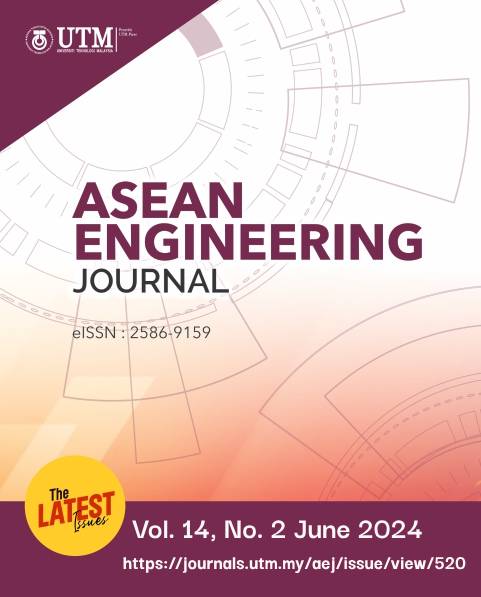THE FIRST APPLICATION OF ULTRA‑HIGH PERFORMANCE CONCRETE LINK SLAB IN MALAYSIA
DOI:
https://doi.org/10.11113/aej.v14.21102Keywords:
Ultra-high-performance concrete, Link slab, Durability, Expansion joints, BridgeAbstract
Conventional expansion joints in road bridges often suffer from issues like leakage, debonded seals, concrete damage, and short service life. To address these problems, a solution involving flexible link slabs using normal strength concrete (NSC) was proposed. While this method can enhance serviceability and reduce maintenance costs, it lacks durability and tensile strength. Recent interest has focused on cast-in-situ ultra-high performance concrete (UHPC) link slabs due to their exceptional mechanical properties, early strength, durability, ductility, and energy-absorption capabilities. However, there is limited information on their field implementation. To address this gap, a pilot UHPC link slab was designed and implemented to replace a damaged bituminous plug expansion joint in a Malaysian road bridge. The pilot link slab followed New York State Department of Transport (NYSDOT) guidelines and used a high early strength UHPC mix with minimal shrinkage through the combination of expansive agents and shrinkage-reducing admixture (SRA). Monitoring the project over two years has shown no performance concerns with the UHPC link slab. This paper provides a comprehensive overview of the construction process, along with experimental results on the mechanical properties and shrinkage characteristics of the new UHPC.
References
S. Mahboubi and M. Kioumarsi, 2021. “Damage assessment of RC bridges considering joint impact of corrosion and seismic loads: a systematic literature review,” Construction and Building Materials,. 295: 123662. doi: https://doi.org/10.1016/j.conbuildmat.2021.123662.
G. Ramberger, 2002 Structural bearings and expansion joints for bridges, 6. doi: https://doi.org/10.1016/b978-0-12-823550-8.00020-2.
F. Kong et al., 2022 “Experimental Research on Properties of UHPC Based on Composite Cementitious Materials System,” Coatings, 12(8): 1219,. doi: https://doi.org/10.3390/coatings12081219.
A. Javanmardi, Z. Ibrahim, K. Ghaedi, N. B. Khan, and H. Benisi Ghadim, 2018. “Seismic isolation retrofitting solution for an existing steel cable-stayed bridge,” PLoS One, 13(7): e0200482. doi: https://doi.org/10.1371/journal.pone.0200482.
J.-F. Belleau, M.-J. Nollet, and A. Khaled, 2023. “Prediction of the required support length at expansion bearings in the context of assessing the seismic vulnerability of existing bridges,” Engineering Structures, 292: 116445. doi: https://doi.org/10.1016/j.engstruct.2023.116445.
A. Javanmardi, K. Ghaedi, F. Huang, M. U. Hanif, and A. Tabrizikahou, 2022. “Application of structural control systems for the cables of cable-stayed bridges: state-of-the-art and state-of-the-practice,” Archives of Computational Methods in Engineering, 29(3): 1611–1641 doi: https://doi.org/10.1007/s11831-021-09632-4.
M. Gordan, Z. B. Ismail, H. A. Razak, K. Ghaedi, and H. H. Ghayeb, 2020. “Optimization-based evolutionary data mining techniques for structural health monitoring,” Journal of Civil Engineering and Construction, 9(1): 14–23, doi: https://doi.org/10.32732/jcec.2020.9.1.14.
M. Gordan et al., 2021. “A brief overview and future perspective of unmanned aerial systems for in-service structural health monitoring,” Engineering Advances, 1(1): 9–15, doi: https://doi.org/10.26855/ea.2021.06.002
M. Gordan, S. R. Sabbagh-Yazdi, Z. Ismail, K. Ghaedi, and H. Hamad Ghayeb, 2021. “Data mining-based structural damage identification of composite bridge using support vector machine,” Journal of AI and Data Mining, 9(4): 415–423, doi: https://doi.org/10.22044/jadm.2021.10430.2182
G. Zi and X. Zhu, 2014. “Asymmetric vibration of finger-type bridge expansion joint for design consideration,” Engineering structures. 70: 53 62. doi: https://doi.org/10.1016/j.engstruct.2014.03.018.
Q. Zhang and Y. Sun, 2023. “Novel metamaterial structures with negative thermal expansion and tunable mechanical properties,” International Journal of Mechanical Sciences, 108692. doi: https://doi.org/10.1016/j.ijmecsci.2023.108692.
R. B. Malla, M. R. Shrestha, M. T. Shaw, and S. B. Brijmohan, 2011. “Temperature aging, compression recovery, creep, and weathering of a foam silicone sealant for bridge expansion joints,” Journal of materials in civil engineering, 23(3): 287 297. doi: https://doi.org/10.1061/(asce)mt.1943 5533.0000166.
J. Scarlata, 2019 “Design and construction of UHPC link slabs,” in International Interactive Symposium on Ultra-High Performance Concrete, 2(1).
M. Hafezolghorani and Y. L. Voo, 2018, “Design of 38m Span Post-tensioned Ultra High Performance Fiber-Reinforced Concrete (UHPFRC) Composite Bridge,” in 14th International Conference on Concrete Engineering and Technology, 431(4): 1–10.
Y. L. Voo, M. Hafezolghorani, and S. Foster, 2018. “Application of ultra-highperformance-fiber reinforced concrete technology for present and future,” in Proceedings of UHPC2018-China, The 2nd International Conference on UHPC Materials and Structures,
B. Graybeal, 2014. “Design and construction of field-cast UHPC connections (No. FHWA-HRT-14-084; HRDI-40/10-14 (750) E).,” Federal Highway Administration, United States,
“New York State Department of Transportation (NYSDOT) 2017.Office of Structures Link Slab Design. Report for the NYSDOT,”
M. A. Kakakhel, F. Wu, J.-D. Gu, H. Feng, K. Shah, and W. Wang, 2019. “Controlling biodeterioration of cultural heritage objects with biocides: A review,” International Biodeterioration & Biodegradation, 143: 104721,
“NF P 18-470, Concrete-Ultra-High Performance Fiber-Reinforced Concrete-Specifications, performance, production and conformity,” 2016.
C. Androuët and J.-P. Charron, 2021. “Shrinkage Mitigation of an Ultra-High Performance Concrete Submitted to Various Mixing and Curing Conditions,” Materials (Basel). 14(14): 3982
“NF P 18-710, 2016. National addition to Eurocode 2-Design of concrete structures: specific rules for Ultra-High Performance Fiber-Reinforced Concrete,”
“ASTM C157/C157M-17, 2017. Standard Test Method for Length Change of Hardened Hydraulic-Cement Mortar and Concrete,”
S. V Shann, 2012. “Application of ultra high performance concrete (UHPC) as a thin-bonded overlay for concrete bridge decks,” Michigan Technological University,
















